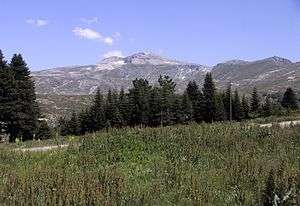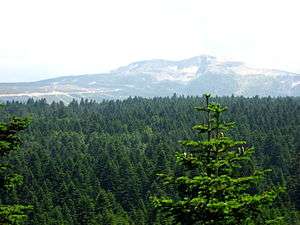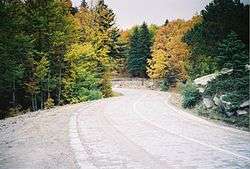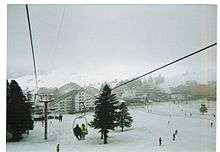Uludağ
Uludağ (pronounced oo loo daa) is a national park and wintersports resort in Southern Marmara of Turkey.

Understand
With its 2,543 m (8,343 ft) summit, Uludağ is the highest mountain of northwestern Turkey. There are some reports and photos that claims its summit is visible from Istanbul about 150 km north as the crow flies on clear days, though this is usually not the case due to humidity.
Uludağ has two sides to it: On one side, it's an untouched natural beauty of forests, hills, and rocks overlooked by eagles and on the other it's a heavily-used resort of wintersports. One might argue there is a third side as well, the relatively small-sized but well-used daily-use areas that are filled with kebab-odour that disseminate from grills of open-air restaurants.
History
Uludağ was one of the twenty-odd mountains around the eastern half of Mediterranean basin that used to be called Olympos in ancient times—more precisely Mysian Olympos in this case, Mysia being the ancient name of the region what is about eastern two-thirds of Southern Marmara today.
In medieval times, Uludağ served as a hermitage to Christian monks, which explains why it was named Keşiş Dağı ("Mountain of the Monks") in Ottoman Turkish. It was also this time when, in the absence of refrigators, the ice harvested from the mountain made its way to the imperial kitchen in Istanbul's Topkapı Palace. The mountain was later renamed Uludağ, which translates "Great Mountain" ("great" being more in the sense of "grand"), in 1935, about a decade after the Turkish Republic was founded.
Uludağ was the first (and, still the most popular) wintersports resort in Turkey, with the first guesthouses aimed at skiing enthusiasts opening in 1940s. It was declared a national park in 1961, but that didn't fully stop tourism developments.
Landscape
Northern side of the mountain overlooking the city of Bursa (though you should be darn lucky to have a glimpse of the city from most locations on the mountain) is dotted with a number of flat plateaus around 1,600 m above the sea level: Sarıalan (the main daily-use area and where cable cars from Bursa terminate), Kadıyayla (where the cable car pauses before heading forward to Sarıalan), Karabelen (when approaching by road, the national park gate is situated here), and Kirazlıyayla (the first plateau after the park gate) among others.
The southern slopes of the mountain is far steeper and is less accessible.
Flora and fauna

Uludağ is one of the places where school geography textbooks come true: the mountain has belts of different types of vegetation varying with the elevation. The lowest slopes bordering Bursa, up to 350 m above the sea level is covered with Mediterranean shrubs (maquis), such as laurel trees. Between 350 through 700 m, it's the warm temperate decidious forests dominated by chestnut trees (this zone is where most of those delicious chestnut desserts unique to Bursa originates from). It's the time for cool temperate decidious woods between 700 to 1,500 m, dominated by beech trees. 1,500 to 2,100 m is the highest belt that still allow trees to grow, dominated by the Turkish firs (Abies nordmanniana subsp. bornmuelleriana), which have their widest distribution in northwestern Turkey in the world. Tree-less and fragile alpine meadows cover the areas of mountain above 2,100 m.
Bears, wolves, deers, and eagles among others are the dwellers of Uludağ.
Climate
As you may be expecting, Uludağ is far chillier than nearby Bursa thanks to its elevation. The wintersports season, especially skiing, is between October and April, with a guaranteed stable snowcover and constant below freezing temperatures between December and March. A summer day that is sweltering hot in Bursa is likely to be cool enough that makes it really uncomfortable without at least a cardigan outdoors in Uludağ during the day and definitely at night.
Get in

The narrow (wide enough for vehicles to pass side by side though) and tarmac road from Bursa (with signs pointing it all around the city) winds on the side of the mountain for 22 km until it arrives at the national park gate at Karabelen. After the gate, it turns into—or rather isn't upgraded from since it was opened—a cobbled road, presumably to force drivers to lower their speed, so that driving under icy conditions in winter on this winding road is safe. The cobbled road lasts for 8 km until Sarıalan, or 12 km until Oteller (area where all hotels are clustered).
In winter, vehicles without tire chains may not be allowed to go further than park gate if park authorities decide so (which usually do so in heavily-snowing days). Fortunately, you'll see a lot of stalls run by local people on sides of the road which sell chains—though they'll for sure try to rip you off if it's one of those no-cars-without-chains days (like trying to sell the chain for up to 100 TL, whereas it would cost about 15 TL elsewhere). Whether a snowy day or not, winter driving rules apply.
30-person cable cars (teleferik) from Bursa's upper neighbourhood of Teferrüç on the foothills of the mountain (minibuses with signs Teferrüç – Teleferik get there from central Bursa) take a much more direct route than the road. It takes around 20-25 minutes to get to the Sarıalan station located at 1,634 m above the sea level. At about mid-way up to Sarıalan, there is a change station at Kadıyayla. Because of space constraints, no skiing/snowboarding equipment is allowed in the cable car, but fortunately you can rent them up on the mountain. As of May 2018, teleferik ride from Teferrüç to Sarıalan costs 67 TL pp return, 54 TL one-way. Students with Turkish student cards or ISIC cards 27 TL return. There's also a discount for over 65 and children. Opening times are advertised as 10 am to 6 pm. Currently the cable car only goes to Sarıalan, even though a higher up station exists. The price remains the same, whichever exit you choose. Cable car service may be cancelled due to bad weather, especially in wintertime.
15-person dolmuşes depart from Bursa when full, and have no fixed hours. Their departure stop is in Tophane, next to the Saltanatkapı gate of old city walls. It takes around 50 minutes to get to Oteller, their last stop in Uludağ, by these dolmuşes and a one-way trip costs 9 TL pp. There are also dolmuş taksis with a capacity of four passengers available, which naturally have less waiting times until they are full, and which cost 15 TL pp one-way.
Fees and permits
A flat rate—which doesn't depend on the number of passengers—for vehicles is charged at the national park gate. Bigger the vehicle, more expensive the fee (though not prohibitively so).
Get around
Minibuses (dolmuş) are available from Sarıalan cable car station to Oteller area, about 10 km away and where all of the hotels are located.
2-person gondola lifts (telesiyej) start from their separate station next to the cable car station in Sarıalan and head to Çobankaya plateau 3 km away and about 100 m higher than Sarıalan. A return ticket on gondola lift line costs 10 TL pp, with a 50% reduction for children aged 7-12.
See
- At Bakacak Plateau a kilometre north of Çobankaya—where gondola lifts from Sarıalan terminate; accessible by a paved road from there as well as from Oteller area—you can have a large overlooking view of the region around the mountain, including the city of Bursa just north of Uludağ, and Lake Apollonia (Apolyont Gölü or Ulubat Gölü in Turkish), about 50 km to west. On your way there, you may also check out Çobankaya—literally "shepherd's rock"—itself, a huge granite boulder, situated on the side of the road.
Do
The "two sides" of Uludağ is also evident in the activities it offers: in wintertime it's skiing down the white slopes, in summertime it's taking a walk amidst the woods.
Skiing

Uludağ is the oldest wintersports resort of the country with the first hotel opened in 1940s. Uludağ offers a number of tracks between fir trees, each with a different level of hardness. Lots of teleskis are available, though unlike many other wintersports resorts around the world, there is not a universal teleski pass system in Uludağ, so you may have to pay each time you use a teleski unless you are using your hotel's own, although there are daily passes valid for each individual teleskis, which cost 80 TL a day.
Ski equipment can be rented on the mountain for 15-25 TL a day.
Hiking
Although none of them waymarked, there is a number of hiking trails on the mountain, with the most popular ones being the trail through the forest from Sarıalan to Çobankaya and the trail above the treeline to the glacial lakes and the summit, which you can start from the abandoned wolfram mine (location simply known as Volfram) east of Oteller area (there are two ways to get to Volfram from Oteller: a footpath starting from 1. Gelişim Bölgesi, or a car-accessible road starting from 2. Gelişim Bölgesi). Volfram to lakes and summit hike is reported to take place along a non-waymarked but obvious trail which forks in about an hour and a half after you started walking: trail to right leads to the summit—the roof of northwestern Turkey where you can catch a glimpse of part of the distinctive crocodile-like shape of the Sea of Marmara and a distant silhouette of Istanbul beyond on clear days—while the one to left leads to the lakes—four of them roughly in a row, most of which are partly ice-covered even in the height of summer unless in an exceptional year. Hiking Volfram to either location is said to take around 3 hours—though those wishing to see both the summit and the lakes close-up better take their camping gear with them since, although near each other, hiking to both locations and then back at the same day is said to be demanding.
Buy
There are a number of kiosks/grocery stores on the mountain, although like almost anything else offered by commercial establishments in Uludağ, they provide snacks and drinks for about three times of what you'd pay elsewhere.
Eat
Around Sarıalan is a number of open-air Kendin Pişir Kendin Ye ("Cook it yourself!") restaurants mostly favoured by Middle Eastern (especially Saudi) families where you buy your meat by kilo and rent a grill with some charcoal and cook your kebab yourself. Most, if not all, of these restaurants are open round the year.
Otherwise, all hotels in Uludağ are full-board and you'll have your meals in your hotel.
Drink
|
Water, anyone? Uludağ is a word you will quite frequently notice on water bottle labels in Turkey, while travelling in northwestern parts in particular, as the springs and creeks in the foothills of the mountain provide much of the country's bottled water, especially those produced by bigger brands. |
The cafés and bars of the hotels are open to anyone (for a fee, unless you stay there, of course). Expect to pay dearly, though—a cup of coffee can easily cost 15 TL in winter.
Sleep
Although a national park, being a wintersports resort means that those preferring a luxurious bed rather than a bumpy mat under the tentfloor won't be disappointed in Uludağ.
Lodging
All hotels in Uludağ are located in Oteller (literally "hotels") area, which is divided into 1. Gelişim Bölgesi, the older development area and 2. Gelişim Bölgesi, the newer development area with a few km inbetween. 1. Gelişim Bölgesi is reported to be livelier than 2. Gelişim Bölgesi. Many hotels in Uludağ, though, are aimed at skiers and thus are closed during summer.
- Ağaoğlu My Resort, ☎ +90 224 285-20-01, e-mail: info@agaoglumyresort.com.tr. Rooms with central heating, wireless internet connection, TV. Hotel offers conference rooms, its own skiing track and a number of teleskis, and indoors swimming pool.
- Atasu Otel, 1. Gelişim Bölgesi, Oteller, ☎ +90 224 285-20-71, fax: +90 224 285-20-73, e-mail: atasu@atasuotel.com.tr. Rooms with en suite bathrooms, central heating, satellite TV, wireless internet connection, and a minibar (with everything in it free of charge). Skiing and snowboarding equipment rental is available.
- Otel Beceren, Oteller, ☎ +90 224 285-21-11, fax: +90 224 285-21-19, e-mail: info@beceren.com.tr. A hotel open year-round, offering rooms with satellite TV. Hotel has a skiing equipment rental service, conference rooms, and day-care for children.
- Otel Fahri, ☎ +90 224 285-20-10, fax: +90 224 285-20-18, e-mail: info@otelfahri.com. Family-run hotel offering rooms with en-suite bathrooms, satellite TV, internet connection, and forest view. Hotel also offers its own teleski and skiing track with cafes at both ends, sauna, and children day care room.
- Hotel Grand Yazıcı, 1. Gelişim Bölgesi, Oteller, ☎ +90 224 285-20-50, fax: +90 224 285-20-48, e-mail: sales@grandyazici.com. Rooms with en-suite bathrooms, satellite TV, central heating, and safeboxes. The hotel offers skiing training and equipment rental, and also has teleskis free of charge (for customers) operating 9AM-5PM.
- Kartanesi Otel, 2. Gelişim Bölgesi, Oteller, ☎ +90 224 285-25-21, fax: +90 224 285-23-57, e-mail: info@kartanesiotel.com. Rooms with en suite bathrooms, and safeboxes. Disabled-accessible rooms are also available. Hotel offers indoors swimming pool, sauna, movie theater, skiing equipment rental, skiing training, carpark, and five teleski lines and two gondola lines accessing to tracks with intermediate and advanced hardness.
- Monte Baia Uludağ, 2. Gelişim Bölgesi, Oteller, ☎ +90 224 285-23-83, fax: +90 224 285-22-02, e-mail: monte@baiahotels.com. Rooms with en suite bathrooms, satellite TV, heating, safeboxes, and carpet floors. Hotel offers five teleski and two gondola lift lines. Skiing training, baby sitting service, indoors swimming pool, spa&wellness centre, wireless internet connection, internet cafe, conference rooms, carpark are among what is available in the hotel.
Camping
Organized campgrounds run by Turkish Ministry of Forestry can be found in Sarıalan and in Çobankaya, in somewhat cramped and relatively crowded conditions, which goes for a nightly fee of 10 TL per tent.
Backcountry
It's possible to wild camp pretty much anywhere in the mountain as long as you are out of the tourism development zones (namely the cluster of restaurants at Sarıalan, the official campground at Çobankaya, and the conglomeration of hotels at Oteller) and the obvious trails—and, indeed, wild camping is your only option in the summit and the glacial lakes area. However, this said area, along with the others above the tree line, is covered with alpine meadows, some of the most fragile ecosystems in the world, so it's important to follow leave-no-trace guidelines there.
Stay safe
- A heavy fog can quickly set on any day in Uludağ, even on a perfectly sunny one. With the loss of sight of natural distinguishers, it becomes fairly hard to follow the trails, especially on the higher meadows of the mountain, so stay ahead of weather forecasts if you're planning to hike. If you are trapped in fog, the best would be to wait until it goes away—it can rise as quick as it forms.
- Bear encounters may take place in the remoter parts of the mountain.
- A related danger, perhaps more frightening than the bears themselves, are bear traps. These are not the violent type that ruptures the legs when closed, but wire meshes set in a large area, that keep the unfortunate bear that happened to walk in motionless by wrapping all around its body. Keep these in mind if you'll hike away from the established trails, especially in the lower foothills near the villages, and make sure you have accustomed to your surroundings before the night falls, should you decide to camp deep in the forest. Being a national park, all wildlife is under protection and these traps are completely illegal, so if you come across with a trapped bear—which can easily be recognized by their constant shrieks even from a long distance away—immediately call jandarma (phone # 156); this will lead to the rescue of the bear, and the prompt destruction of the trap.
Go next
Getting out of the mountain generally means backtracking to Bursa, although there are some tracks leading to remote villages at the eastern and southern foothills of the mountain.